Trump asks US Supreme Court to lift ban on deportations under wartime law
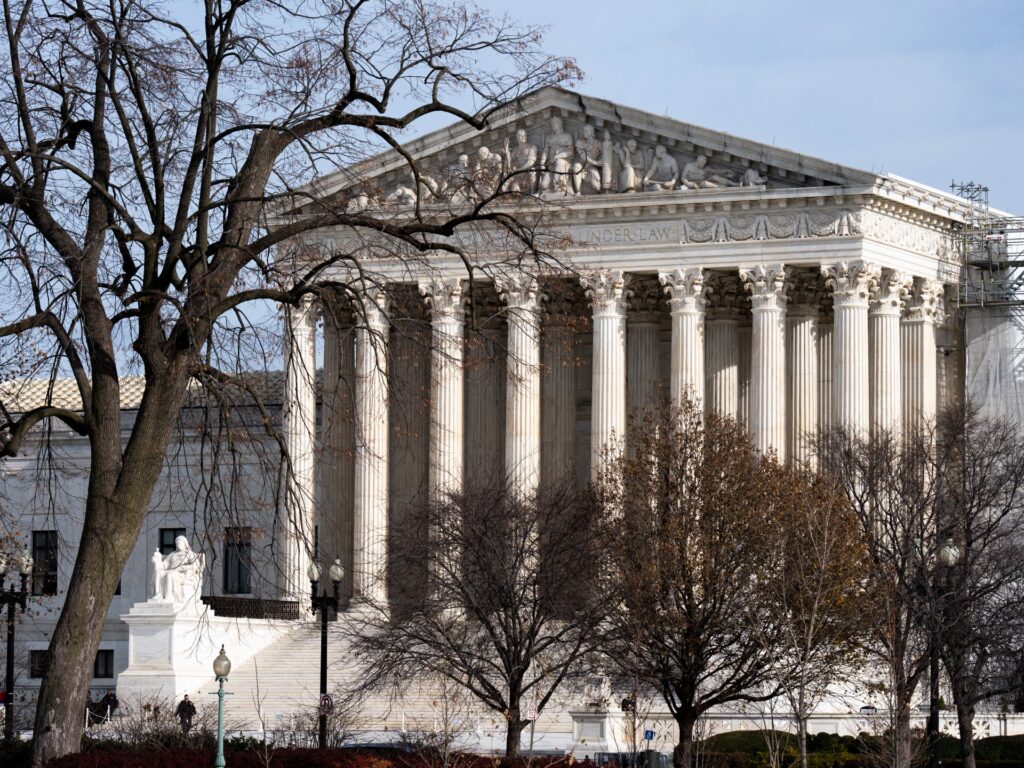
US president appeals to Supreme Court to overturn a lower court ban on his use of an obscure wartime law. The Trump administration has asked the Supreme Court for permission to resume deportations of Venezuelan migrants to El Salvador under an 18th-century wartime law, while a court fight continues. The Department of Justice asked the court in a filing to lift Washington, DC-based US District Judge James Boasberg’s March 15 order calling for a temporary halt to the summary removals of the Venezuelans while a legal challenge to Trump’s invocation of the Alien Enemies Act to justify the deportations plays out. The 18th-century law has historically been used only in wartime. The Justice Department said in its filing on Friday that the case presents the question of who decides how to conduct sensitive national security-related operations, the president or the judiciary. “The Constitution supplies a clear answer: the President,” the department wrote. “The republic cannot afford a different choice.” President Donald Trump invoked the Alien Enemies Act for the first time since World War II to justify the deportation of hundreds of people under a presidential proclamation calling the Tren de Aragua gang an invading force. Advertisement “Here, the district court’s orders have rebuffed the President’s judgements as to how to protect the Nation against foreign terrorist organizations and risk debilitating effects for delicate foreign negotiations,” acting Solicitor General Sarah Harris wrote in the court filing. Flashpoint case Lawyers from the American Civil Liberties Union filed the lawsuit on behalf of five Venezuelan noncitizens who were being held in Texas, hours after the proclamation was made public. The court set a Tuesday deadline for a response from the ACLU. The case has become a flashpoint amid escalating tension between the White House and the federal courts. Trump’s administration has argued that Boasberg’s temporary ban encroached on presidential authority to make national security decisions. On March 18, Trump called for Boasberg’s impeachment by Congress – a process that could remove him from the bench – drawing a rebuke from the US Chief Justice John Roberts. Trump on social media called Boasberg, who was confirmed by the US Senate in 2011 in a bipartisan 96-0 vote, a “Radical Left Lunatic” and a “troublemaker and agitator.” The DC Circuit upheld Boasberg’s order after holding a contentious hearing that involved heated language. Judge Patricia Millett told Justice Department lawyer Drew Ensign that “Nazis got better treatment under the Alien Enemies Act than has happened here.” Ensign responded, “We certainly dispute the Nazi analogy.” Family members of many of the deported Venezuelan migrants deny the alleged gang ties. Lawyers for one of the deportees, a Venezuelan professional football player and youth coach, said US officials had wrongly labeled him a gang member based on a tattoo of a crown meant to honor his favorite team, Real Madrid. Advertisement The Alien Enemies Act allows noncitizens to be deported without the opportunity for a hearing before an immigration or federal court judge. Boasberg ruled that immigrants facing deportation must get an opportunity to challenge their designations as alleged gang members. His ruling said there is “a strong public interest in preventing the mistaken deportation of people based on categories they have no right to challenge.” Adblock test (Why?)
Earthquakes in Myanmar spread destruction as far as Bangkok
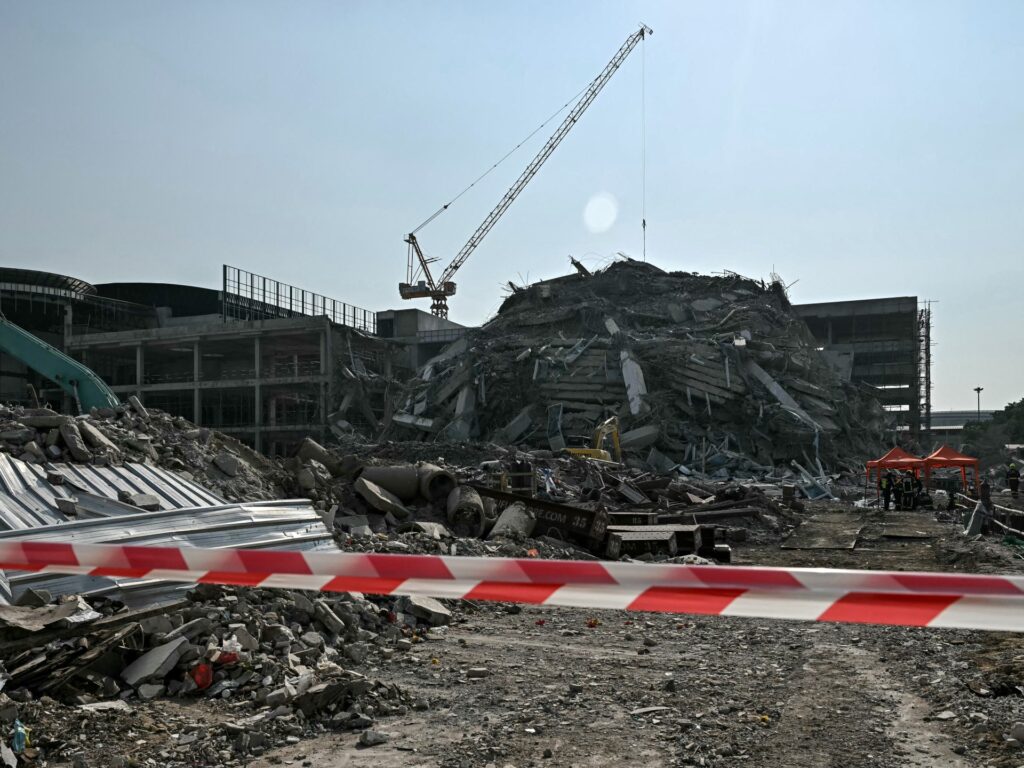
NewsFeed Twin earthquakes shook Myanmar causing extensive damage and killing at least a dozen people. The quakes, one a 7.7 magnitude, were also felt in Bangkok, Thailand where a tower block collapsed trapping dozens of construction workers. Published On 28 Mar 202528 Mar 2025 Adblock test (Why?)
Israel launches first air strike on Lebanon’s Beirut since November truce
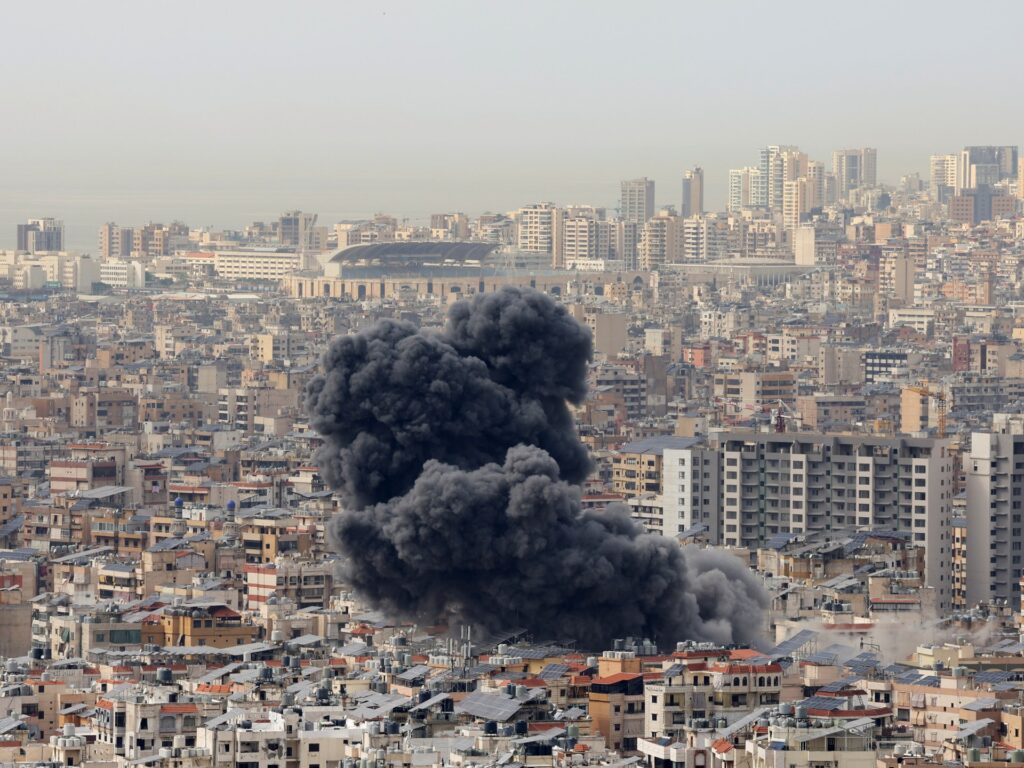
Israeli attack destroys a residential building in a Beirut suburb as France’s Macron decries ‘unacceptable’ strike. Israel has carried out an air strike on Lebanon’s capital for the first time since a fragile truce between the Israeli army and the Lebanese armed group Hezbollah in November halted a war between the two. Residents fled as a building was flattened in the Hadath neighbourhood in Beirut’s southern suburbs on Friday when Israel carried out four strikes – an attack reminiscent of the months-long bombing campaign of last year when Israeli jets pounded the area. “We are by the building attacked by Israel, and it is total destruction here,” Al Jazeera’s Ali Hashem reported. “It is a residential block in which many families lived, and many of them watched the building as Israeli warplanes destroyed it.” Hashem said surrounding apartments and shops were damaged in the attack. The Israeli military said the target was a Hezbollah military storage facility for drones. Israel launched the attack after rockets were fired from Lebanon towards Israeli territory, the second such incident in the past week. Hezbollah denied involvement both times, and no other group has claimed responsibility. Advertisement Prime Minister Nawaf Salam told the Lebanese army to quickly identify and arrest those responsible for the rocket fire, saying it “threatens Lebanon’s stability and security”, according to a statement from his office. Israeli Defence Minister Israel Katz said the Lebanese government bears direct responsibility for the rocket fire and, as long as there was no peace in northern Israel, “there will be no peace in Beirut either.” Israel and Hezbollah traded fire for more than a year after the Lebanese armed group started firing rockets towards northern Israel in October 2023 in what it said was solidarity with Hamas in Israel’s war in the Gaza Strip. The exchanges of fire continued for months until Israel dramatically escalated the conflict in September and killed much of Hezbollah’s leadership before the two parties signed a ceasefire on November 27. According to the United States- and French-brokered deal, Israel should have pulled out its troops from southern Lebanon, but it has failed to withdraw soldiers from five locations in Lebanon. For its part, Hezbollah agreed to move its fighters and weapons north of the Litani River to leave southern Lebanon under the sole military control of the Lebanese army. Macron criticises Israeli strike Speaking in Paris, Lebanese President Joseph Aoun said the strike on the Beirut suburbs was a continuation “of Israel’s violations of the agreement” sponsored by France and the US. During a joint news conference with Aoun, French President Emmanuel Macron called the attack “unacceptable” and promised to address it with Israeli Prime Minister Benjamin Netanyahu and US President Donald Trump. Advertisement United Nations Special Coordinator for Lebanon Jeanine Hennis-Plasschaert said the escalation had created “a critical period for Lebanon and the wider region”. Israel has promised a strong response to any threats to its security, prompting fears that last year’s war – which displaced more than 1.3 million people in Lebanon and destroyed much of the country’s south – could resume. Political analyst Yossi Beilin told Al Jazeera that “the fact that Israel reacted in Beirut for the first time since the ceasefire is very relevant and consequential.” “This is the time and place for the Americans and the French to put an end to the current situation,” Beilin said. “Hezbollah is not Lebanon,” but it is a “militia that is independent and that is the difficulty we are facing here”, he said. Israel also carried out attacks in the town of Kafr Tibnit in southern Lebanon on Friday, killing three people and wounding 18, including children and women, according to Lebanon’s Ministry of Public Health. Adblock test (Why?)
Trump holds ‘extremely productive call’ with Canadian prime minister: ‘We agree on many things’
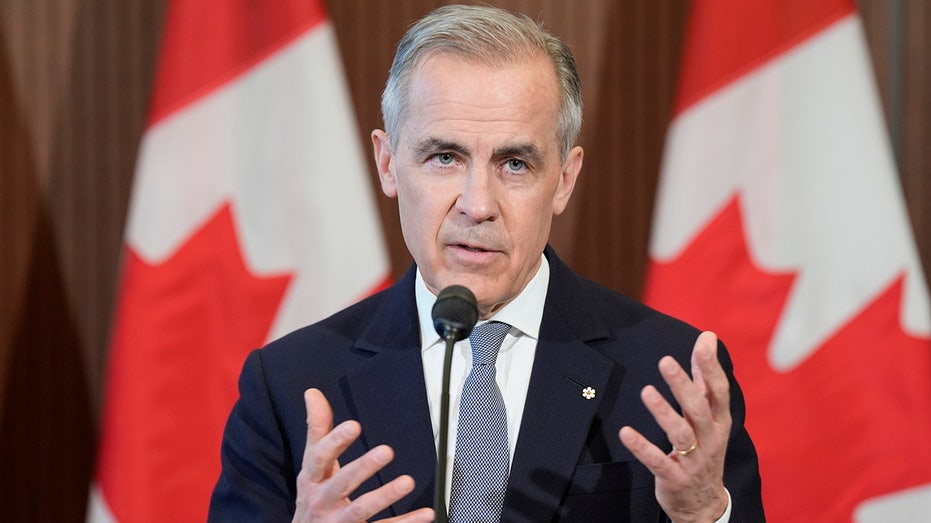
President Donald Trump said he held an “extremely productive call” with Canadian Prime Minister Mark Carney on Friday. “I just finished speaking with Prime Minister Mark Carney, of Canada. It was an extremely productive call, we agree on many things, and will be meeting immediately after Canada’s upcoming Election to work on elements of Politics, Business, and all other factors, that will end up being great for both the United States of America and Canada,” Trump wrote on this Truth Social account. It was the first time the two leaders have spoken. On Thursday, Carney said the “old relationship” with the United States “is over” while vowing to engage in a renegotiation over a trade agreement. Carney, 60, who won the Liberal leadership this month with 86% of the vote after former Prime Minister Justin Trudeau stood down, was speaking in Ottawa after meeting the nation’s provincial premiers. CANADIAN PRIME MINISTER MARK CARNEY SAYS ‘OLD RELATIONSHIP’ WITH US ‘IS OVER’ “The old relationship we had with the United States, based on deepening integration of our economies and tight security and military cooperations, is over,” he told reporters. “The time will come for a broad renegotiation of our security and trade relationship.” CANADA EXPLOITING ‘LOOPHOLE’ HURTING US DAIRY FARMERS AMID TRUMP TARIFFS, SENATORS SAY “What is clear is that we as Canadians have agency. We have power. We are masters in our own home,” he also said. “We control our destiny. We can give ourselves much more than any foreign government, including the United States, can ever take away,” Carney added. Fox News Digital’s Louis Casiano contributed to this report.
State Department will absorb remaining USAID programming as independent agency is dismantled
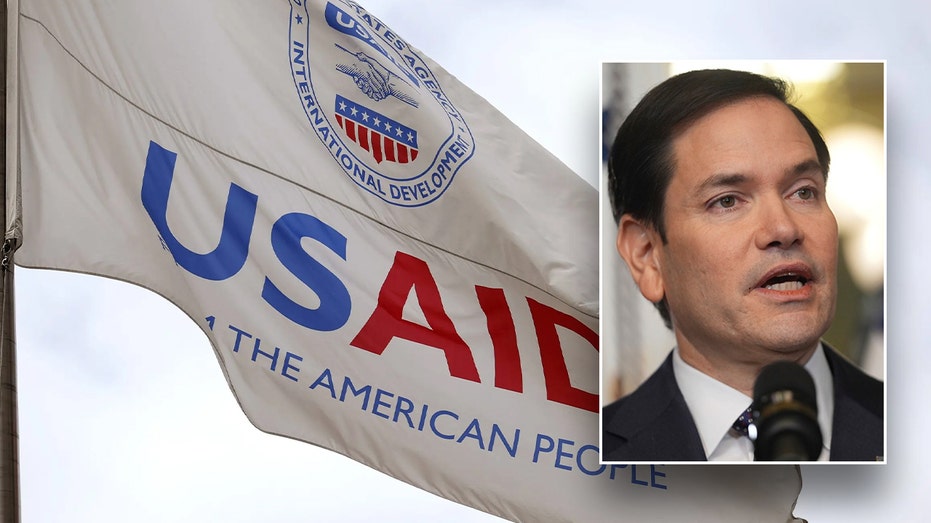
FIRST ON FOX: The State Department is absorbing the remaining operations and programs U.S. Agency for International Development (USAID) runs, upending its function as an independent agency, according to an internal USAID memo obtained by Fox News Digital. While USAID historically has functioned as an independent agency that works to deliver aid to impoverished countries and development assistance, President Donald Trump appointed Secretary of State Marco Rubio to serve as acting administrator of the organization in February amid concerns that USAID did not advance U.S. core interests. Now, the State Department is poised to officially take on USAID programs as part of a merger that aims to streamline operations to deliver foreign assistance, the memo said. It also will result in cuts for thousands of USAID employees. “By bringing USAID’s core life-saving and strategic aid programs under the umbrella of the State Department, this Administration will significantly enhance the efficiency, accountability, uniformity, and strategic impact of foreign assistance programs — and ensure that our nation and President to speaks with one voice in foreign affairs,” Jeremy Lewin, who is performing the duties of USAID Deputy Administrator for Policy and Programming & Chief Operating Officer, said in a Friday statement to Fox News Digital. ‘HYSTERIA’: WHITE HOUSE SHUTS DOWN CONCERNS OVER USAID DOCUMENT PURGE As a result, the State Department is moving to “retire” USAID as an independent operation and is moving forward with plans for a reduction in force, according to the memo. Altogether, more than 4,650 USAID personnel will be cut from USAID, according to a State Department senior official. Personnel will start to receive notices Friday regarding their status at USAID with separation dates either on July 1 or Sept. 2. Between those three months, the State Department will take on responsibility for USAID programming, and will assess staffing requirements to proceed with an independent hiring process. Eligible USAID employees may apply for those positions as remaining USAID personnel move to shut down or transfer USAID operations to the State Department. “A separate process will be established for hiring personnel into available roles at the State Department,” the USAID memo said. “While the details are still being finalized, we are committed to sharing additional information as soon as it becomes available, likely in April or May.” The announcement comes as the Trump administration has moved to shutter USAID amid widespread government cuts stemming from the Department of Government Efficiency (DOGE) that SpaceX and Tesla CEO Elon Musk is leading. USAID has come under scrutiny amid DOGE’s cuts for wasteful spending that didn’t align with the Trump administration, including funding a $1.5 million program aimed to “advance diversity, equity and inclusion in Serbia’s workplaces and business communities and a $70,000 program for a “DEI musical” in Ireland. ‘FIRED ME ILLEGALLY’: EMOTIONAL EX-USAID EMPLOYEES LEAVE BUILDING WITH BELONGINGS AFTER MASS LAYOFFS Rubio said March 11 that the State Department had concluded a six-week review and would cancel more than 80% of USAID programs. That translates to an elimination of roughly 5,200 of USAID’s 6,200 programs. “Foreign assistance done right can advance our national interests, protect our borders, and strengthen our partnerships with key allies,” Rubio said in a statement to Fox News Digital Friday. “Unfortunately, USAID strayed from its original mission long ago. As a result, the gains were too few and the costs were too high.” “We are reorienting our foreign assistance programs to align directly with what is best for the United States and our citizens,” Rubio said. “We are continuing essential lifesaving programs and making strategic investments that strengthen our partners and our own country.”
House Judiciary calls on Biden DOJ prosecutor to testify in Dr Eithan Haim case
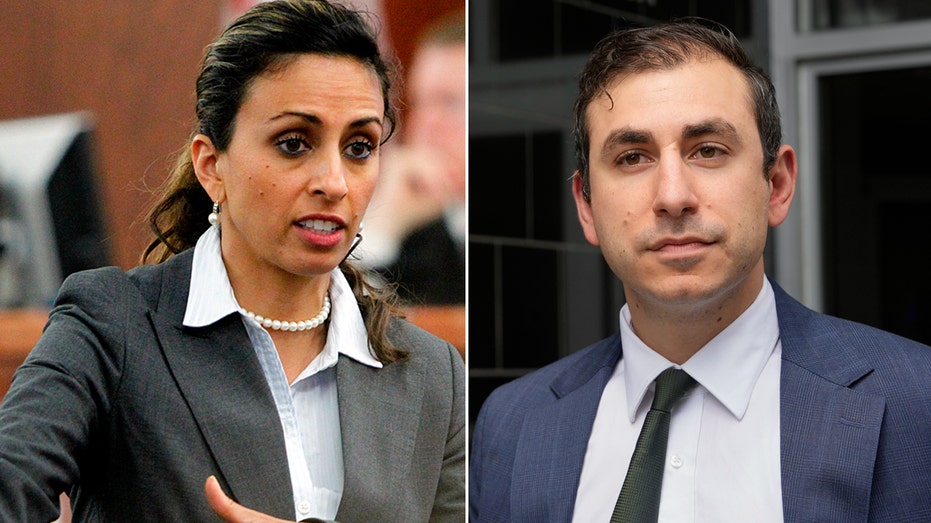
FIRST ON FOX: The House Judiciary Committee sent a letter Thursday to Tina Ansari, the lead federal prosecutor in a case brought by the Biden Department of Justice, against Dr. Eithan Haim for leaking records that revealed Texas Children’s Hospital was performing medical procedures on minors. Ansari indicted Haim on federal charges after he exposed the Texas medical system for performing transgender medical procedures on minors. Ansari was removed from the criminal case, which has since been dismissed by the Trump Justice Department, after information showed that her family was involved extensively in business dealings with the Texas medical hospital system. NFL LEGEND BRETT FAVRE SLAMS OREGON HS OFFICIALS AFTER TRANS RUNNER BLOWS AWAY FEMALE COMPETITION Fox News Digital obtained the letter to Ansari, which reads, “You were the lead prosecutor on Dr. Haim’s case. You allegedly were removed from the case for failing to report an enormous conflict of interest stemming from the substantial financial and political ties to your close family members.” “This lack of candor and apparent conflict of interest raises further concerns around DOJ’s weaponization against Dr. Haim for blowing the whistle on [Texas Children’s Hospital]. Your testimony will inform the Committee’s legislative reforms aimed at enhancing civil liberties, protecting minors, combatting conflicts of interest, and preventing and prohibiting the weaponization of DOJ to prosecute individuals for holding disfavored viewpoints.” A source familiar with the hearing told Fox News Digital that Haim and his attorney, Mark Lytle, are expected to testify alongside Ansari. TRUMP ADMIN CUTS ADDITIONAL $1M IN FEDERAL FUNDING FOR ‘TRANSGENDER ANIMAL’ EXPERIMENTS Marcella Burke, Haim’s attorney at the time President Donald Trump’s Justice Department dismissed the case, told Fox News Digital in January, “The case has been dismissed with prejudice so that the federal government can never again come after him for blowing the whistle on the secret pediatric transgender program at Texas Children’s Hospital.” During the case, Haim’s lawyers argued that the leaked files contained redacted patient information despite DOJ prosecutors claiming that the records contained the names of children who had been receiving puberty-blocking devices, among other gender transition procedures. MAINE HIGH SCHOOL ATHLETE SENDS MESSAGE TO GOVERNOR AMID TRANS-ATHLETE POLICY CONTROVERSY Haim faced up to 10 years in federal prison and a maximum fine of up to $250,000 if he would have been found guilty in the Biden DOJ-driven indictment.
US accuses Denmark of treating Greenlanders as ‘second-class citizens’ during Vance visit to Arctic base
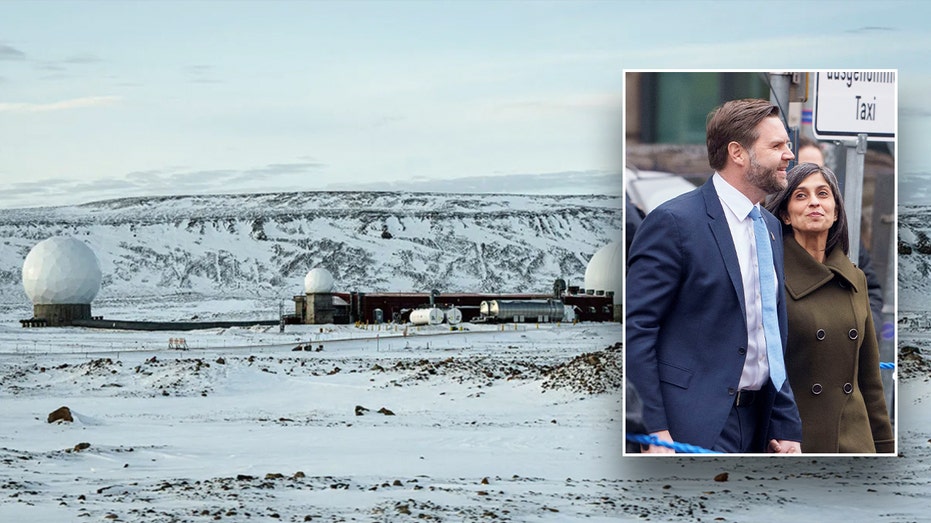
Vice President JD Vance and second lady Usha are visiting Greenland on Friday, an island of less than 60,000 people that has become central to President Donald Trump’s foreign policy. The Vances are visiting Pituffik Space Force Base, where they will receive a briefing on Arctic security issues and meet with U.S. service members. “The Vice President and Second Lady are embarking on a historic expedition with their visit to Greenland, where the vice president will emphasize the importance of bolstering Artic security in places like Pituffik Space Base,” a senior White House official said. “Unfortunately, Danish leaders have spent decades mistreating the Greenlandic people, treating them like second class citizens and allowing infrastructure on the island to fall into disrepair. Expect the Vice President to emphasize these points as well.” Usha Vance was originally slated to travel to Greenland without the vice president on a cultural trip to watch a dog sledding race. However, earlier this week the vice president opted to join, and the trip was shifted to focus on national security. TRUMP SAYS ‘WE NEED GREENLAND FOR INTERNATIONAL SAFETY AND SECURITY’ AHEAD OF VANCE TRIP Vance is the highest-ranking official to ever travel as far north as Pituffik, the White House said. Vance’s first trip abroad to Paris and Germany made waves for his tough talk on Europe, which iced over the U.S.’ relationship with some nations but precipitated a mobilization of funding by Europe for its own defense. Trump has made it a mission to take over Greenland from Denmark in his second administration. “We need Greenland for national security and international security,” he told reporters in the Oval Office. VANCE EVISCERATES ‘SOVIET’-STYLE EUROPEAN CENSORSHIP IN ADDRESS TO MUNICH SECURITY CONFERENCE “So we’ll, I think, we’ll go as far as we have to go,” he continued. “We need Greenland. And the world needs us to have Greenland, including Denmark. Denmark has to have us have Greenland. And, you know, we’ll see what happens. But if we don’t have Greenland, we can’t have great international security.” “I view it from a security standpoint, we have to be there,” Trump added. Greenland relies heavily on welfare from Denmark, which currently contributes around half of its annual budget, amounting to around $700 million per year. In January, in response to Trump’s stated ambitions, Denmark announced it would spend another $2 billion to bolster defenses on the island. VANCE CELEBRATES ‘NO MORE QUOTAS’ IN THE MILITARY AS HE FIRES GUNS AND VISITS WITH MARINES The Trump administration has dangled billions for Greenland to invest in developing its natural resources — rare Earth minerals and oil and gas reserves. However, mining Greenland has proven notoriously difficult given that 80% of the island is covered in a sheet of ice. Greenland’s Prime Minister Mute Egede earlier this week called the upcoming Vance visit “very aggressive American pressure against the Greenlandic community” and called on European leaders to stand against it. CLICK HERE TO GET THE FOX NEWS APP Trump established the Space Force in 2019 as a way to defend against encroachment on America’s interests in Earth’s orbit. In recent years, China and Russia have stepped up their Arctic presence, investing in icebreakers, new nuclear submarines and rare Earth minerals.
Magnitude 7.7 earthquake in Myanmar; tremors felt in Thailand: All we know
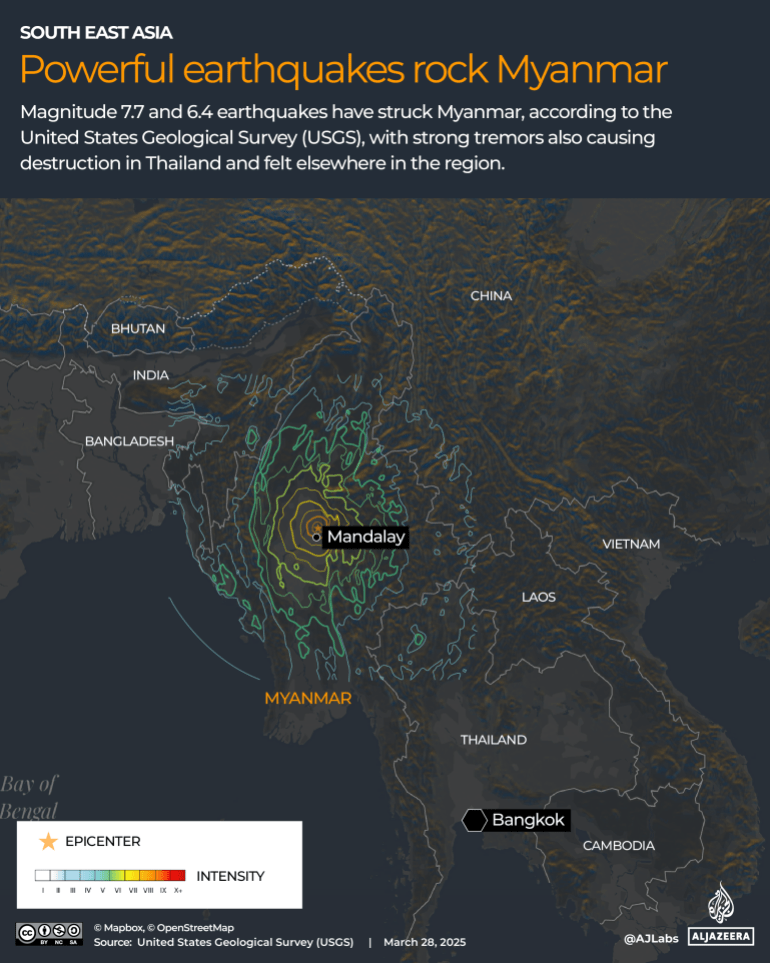
Two powerful earthquakes of magnitude 7.7 and 6.4 have hit central Myanmar, causing death and large-scale destruction in both Myanmar and neighbouring Thailand. Friday’s tremors were also felt elsewhere in the region. Authorities in Myanmar imposed a state of emergency in six states after structures collapsed and multiple deaths and injuries were reported. Later on Friday, state-run MRTV wrote on the Telegram messaging app that at least 144 people had been killed and 732 injured in the country. The United Nations Secretary-General Antonio Guterres said the UN was “mobilising” in Southeast Asia to help those in need. Here is everything we know about the disaster so far: What happened in Myanmar? About 12:50pm (06:20 GMT), an earthquake of magnitude 7.7 hit 16km (10 miles) northwest of Sagaing city at a depth of 10km (6 miles). This was followed by an aftershock of magnitude 6.4. The earthquake’s epicentre was about 17km (11 miles) west of the country’s second largest city, Mandalay, which has a population of nearly 1.5 million people. Advertisement Al Jazeera’s Tony Cheng was outside Myanmar’s Defence Services Museum in the capital, Naypyidaw, when the earthquake hit. “Suddenly, the building started moving very heavily from side to side,” Cheng said. “Plaster was raining down.” Cheng added that concrete from the roof and support columns of the portico also fell during the quake. “The swaying went on for about 30 seconds to a minute,” he said. “It gained in intensity as it went on. I’ve been in earthquakes in this region before, and I’ve never felt anything as strong as that.” Where else were the earthquakes felt? The tremors were felt across Southeast and South Asia. Thailand: At least nine people have died in Bangkok as a result of the earthquake, Bangkok’s Deputy Governor Tavida Kamolvej told Reuters on Friday evening. Eight of the victims were killed when a 30-storey building that was under construction collapsed, also trapping 43 workers, according to the police and medics. Rescue workers said a further 117 people were missing. The Stock Exchange of Thailand suspended activity on Friday afternoon. Bangkok’s entire public transport system also was shut down for safety reasons, reported Al Jazeera’s Imran Khan, who was in the city when the quake struck. “Traffic is absolutely gridlocked. The buildings have been shuttered in the centre of the city,” Khan said. China: China’s Xinhua news agency reported that shocks were felt in the southwestern province of Yunnan, which lies at the border with Myanmar. No casualties were reported. Advertisement Chinese media also reported that, in the northeast of the country, tremors were felt in Yunnan and Sichuan provinces in China, causing injuries and damage to houses in the city of Ruili, which is on the border with Myanmar. In Mangshi, a city about 100km (60 miles) northeast of Ruili, the shaking was so strong that people were unable to stand, one resident told The Paper, an online media outlet. Tremors were also reported in Cambodia, India and Bangladesh. What do we know about the victims? Myanmar’s state-run MRTV station wrote on Telegram that at least 144 people had been killed in Myanmar and 732 injured. Two people were killed in the town of Taungoo in Myanmar when a mosque partially collapsed, the Reuters news agency reported, quoting witnesses. Local media also reported that a hotel collapsed in Myanmar’s southern city of Aungban, killing at least two people and injuring 20. A doctor at a 1,000-bed general hospital in Naypyidaw told the AFP news agency that 20 people had died there. “About 20 people died after they arrived at our hospital so far. Many people were injured,” the doctor said on the condition of anonymity. Bangkok Governor Chadchart Sittipunt said three people have been killed by the quake in Thailand. Defence Minister Phumtham Wechayachai also said 90 people are missing. A rescue worker from the Moe Saydanar charity group told Reuters that 60 bodies had been retrieved from monasteries and buildings in Pyinmanar, near Naypyidaw, and more people were trapped. Advertisement “This 60 is only from my charity group and only at Pyinmanar town,” he said. How bad is the damage? Infrastructure has taken a heavy hit in Myanmar and Thailand. Buildings, bridges and roads have been destroyed, according to local media. State media in Myanmar said buildings and structures had collapsed in at least five cities and towns. Pieces of the ceiling at the National Museum of Naypyidaw fell as the tremors shook the structure, AFP reported. State media reported that a railway bridge and a road bridge on the Yangon-Mandalay Expressway collapsed. Local media also reported that the Ma Soe Yane monastery had collapsed and the former royal palace had been damaged. The 90-year-old Ava Bridge, also called Old Sagaing Bridge, partially fell into the Irrawaddy River, which flows between Mandalay and Sagaing. How has the government responded? Among the places where Myanmar’s military government has imposed a state of emergency are Mandalay and Naypyidaw. A major hospital in the capital, Naypyidaw, has been declared a “mass casualty area”, an official at the facility told the AFP news agency. Rows of wounded were treated outside the emergency department of the 1,000-bed general hospital, some writhing in pain, others lying still as relatives sought to comfort them. Zin Mar Aung, the country’s shadow foreign minister with the parallel National Unity Government, said troops from the anti-junta groups, known as the People’s Defence Forces, would provide humanitarian assistance. Advertisement “It’s very serious, we need humanitarian and technical assistance from the international community,” Zin Mar Aung told Reuters. “The state will make inquiries on the situation quickly and conduct rescue operations along with providing humanitarian aid,” the government said in a message on the Telegram messaging application. What’s the latest on the ground? Rescue efforts are under way. However, the Red Cross said damaged power lines in Myanmar are impeding rescue teams from reaching Mandalay and Sagaing. The Red Cross said initial reports suggested the quake has caused “significant damage” and “information on humanitarian
Bangladesh cricketer Tamim back home after heart attack

Tamim Iqbal was admitted to hospital on Monday after suffering chest pains while competing in a match in Bangladesh. Former Bangladeshi cricket captain Tamim Iqbal has returned home from hospital, days after suffering a massive heart attack during a local match. The 36-year-old was released on Friday. He was leading Mohammedan Sporting Club in a match of the 50-over Dhaka Premier Division Cricket League on Monday when he was rushed to a nearby hospital, complaining of severe chest pain. Doctors inserted stents to repair an arterial blockage the same day, and Tamim was later moved to a bigger health facility in the capital, Dhaka. “After observing his health condition, we have decided to discharge him today,” Shahabuddin Talukder, a doctor at Evercare Hospital, told reporters on Friday. He added that Tamim would have to maintain a rehabilitation programme and modify his lifestyle. “We hope he will be able to return to cricket soon,” the doctor added. Bangladesh’s Tamim Iqbal enjoyed a 15-year international career, which included appearances at a number of World Cups [File: Matt Dunham/AP] Abu Zafar of the Bangladeshi Ministry of Health and Family Welfare told reporters on Wednesday that it was uncertain whether Tamim would be able to return to cricket. Advertisement “Tamim won’t be able to play sports for the next three months. If everything goes well, then he will be able to return,” he said. “Unfortunately, he is a smoker, which is a risk factor for heart attacks. He must stay away from it. He will have to follow doctors’ advice.” Tamim scored more than 15,000 runs for Bangladesh in a career spanning 15 years and remains the only Bangladeshi to score hundreds in all formats of international cricket. Adblock test (Why?)
Trump administration has no respect for “defence secrets”
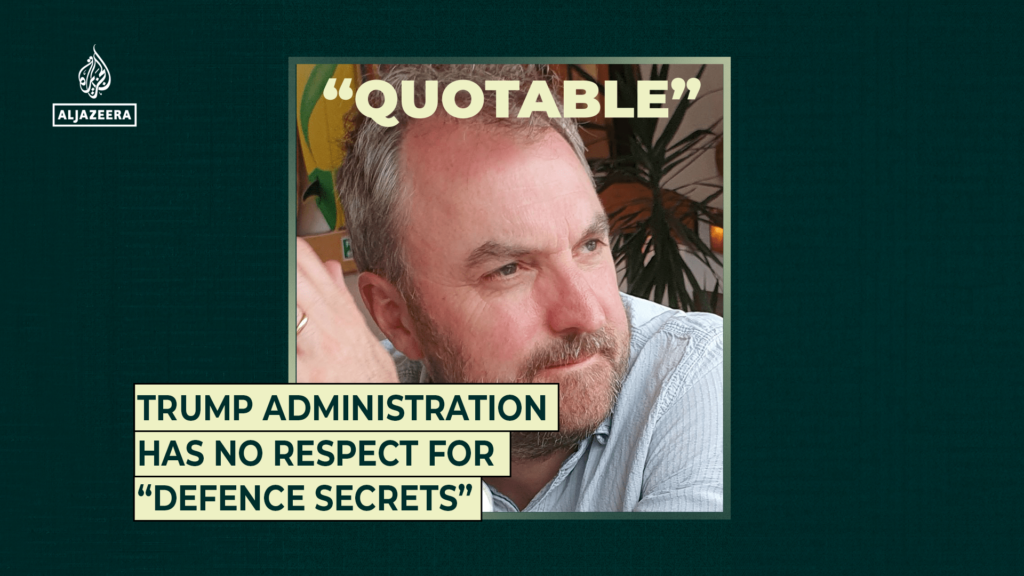
Jamie Gaskarth critiques Trump officials’ disregard for intelligence and defence secrecy risks. Jamie Gaskarth, a professor of foreign policy & international Relations at Open University, analyses the Trump administration’s apparent lack of respect for the sensitivities surrounding intelligence and defence secrets. Adblock test (Why?)

